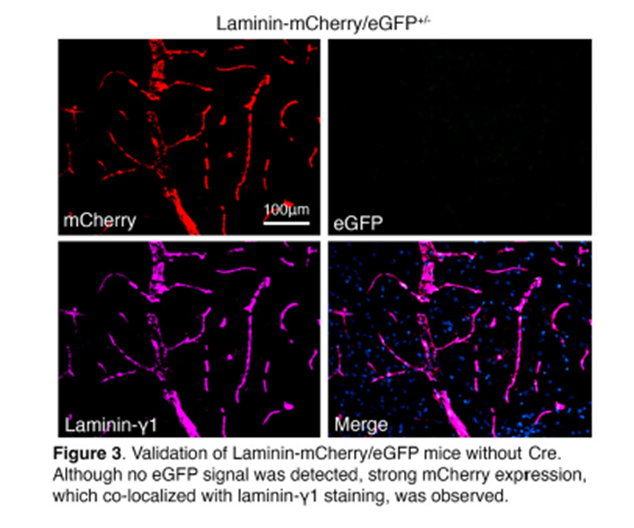Advantages
- First-ever dual-color laminin reporter mouse line.
- Enables visualization of laminin-γ1 expression in vivo with high fidelity.
- mCherry signal replicates endogenous laminin distribution without Cre activation.
- No background eGFP signal ensures clean baseline imaging.
- Targets the widely expressed γ1 subunit, enhancing versatility across tissues and isoforms.
- Compatible with Cre-lox systems for future cell-specific and temporal studies.
Summary
Laminins are key extracellular matrix proteins essential for embryonic development and maintenance of blood-brain barrier (BBB) integrity, but their cellular origins in vivo have remained difficult to resolve due to overlapping deposition by multiple cell types. Traditional antibody-based methods cannot distinguish which cells produce specific laminin isoforms, which has hindered comprehensive understanding of laminin biology.
Our researchers have developed a genetically engineered dual-color reporter mouse line, created via CRISPR-Cas9, for in vivo visualization of laminin-γ1 expression. This dual-color knock-in model incorporates a loxP-mCherry-polyA-loxP-eGFP cassette into exon 28 of the laminin-γ1 gene, enabling precise visualization of laminin expression. Prior to Cre recombinase activation, the mouse expresses mCherry-tagged laminin-γ1, which faithfully replicates endogenous laminin distribution and co-localizes with laminin-γ1 antibody staining in brain tissue. Importantly, no eGFP signal is present in the absence of Cre, ensuring specificity and eliminating background fluorescence.
By targeting the γ1 subunit—present in most laminin isoforms—this mouse line offers broader applicability than previous models, such as the lamb1-Dendra2 mouse, which targets the β1 subunit and lacks cell-specific resolution. The Laminin-mCherry/eGFP mouse thus provides a powerful tool for mapping laminin expression in vivo with cell-type and developmental-stage specificity once crossed with appropriate Cre driver lines.

Desired Partnerships